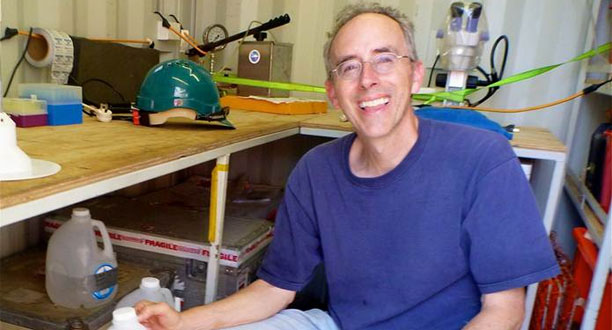The Curiosity Chromosome

Asor Island
This morning we moved the Mermaid Sapphire half a mile east into the lee of Asor Island. It gave more protection from the wind and brought us closer to another of the emerald-green islets that dot the rim of this spectacular lagoon. The breeze was blowing at 20 knots and the tiny stretch of land in front of the ship seemed suspended on the foaming breakers of the outer reef.
The sub team spent all day working on the DEEPSEA CHALLENGER. The dive to the bottom of the Challenger Deep, where the pressure was a thousand times greater than at sea level, took a toll on her hydraulic system, batteries, and some of the thrusters; several of their components are being replaced and tested before the next dive.
At the end of the day a group of us climbed into a small boat, drove close to the island; dropped over the side with masks, fins, and snorkels; and edged a little closer to the real truth of these earth-shaping waters. The bottom of the sea was 40 feet (12 meters) below. We looked into the cathedral-blue depths and saw large, rectangular objects scattered across the seafloor. Then we held our breaths and swam downward for a close-up view of World War II landing craft—small, amphibious assault craft that carried troops from larger ships to the beach. We saw dozens of them scattered across the sediments, full of rusting holes, small fish, and other creatures. They were a reminder that just before the American invasion of Okinawa in 1945, more than 600 ships and tens of thousands of sailors and marines were anchored in this wide, volcanic lagoon.
As we swam closer to the island we saw stretches where stands of coral had been damaged by a recent hurricane. Nearby were areas where it was rebuilding and healthy. Whenever we surfaced to catch our breath, we saw the island reflected on the face of the great waters. Its wide sand beach and old-growth trees, splendid in the late-day sunlight, hinted of an unfinished earth.
No one enjoyed the two hours of exploration more than Professor Doug Bartlett. He took a good look at the landing craft beneath his fins and then swam to shore, made his way up the warm sand beach, and introduced himself to the good people who live on the island of Asor. He was eager to learn more about how they had adapted to life on this remote atoll.
Doug is the expedition’s chief scientist. An acclaimed microbiologist from the Scripps Institution of Oceanography, he’s spent decades studying the nature of microbial life in the most remote and extreme places on Earth, including deep-ocean trenches. His research group pioneered genetic studies of these alien-like microbes and were the first to identify genes regulated by pressures of thousands of pounds per square inch and genes required for high-pressure growth. To have a conversation with him is to discover a whole new world.
“Every second breath we take contains oxygen created by marine organisms,” he says, “And most of them are microbes.” If the conversation turns to the human body, Bartlett reminds you that, “Microbes are the body’s ‘intimate strangers.’ In terms of sheer numbers we have more microbial cells than human cells.” If you ask him about deep-ocean trenches, his eyes light up. “Microbes have adapted to the extreme pressure, darkness, and near-freezing cold of the hadal trenches. They force us to ask fundamental questions. How do they do this? What can we learn from their biogeochemical pathways?”
A few days ago, I had the good fortune to listen to a discussion between Doug and Kevin Hand. It was like listening to two jazz musicians jamming on a favorite theme. They talked about the vast constellation of microbes in the ocean—most of them undiscovered—and how they might equal in number all the stars in the Milky Way. They discussed how microbes, especially those that inhabit the most extreme environments on Earth, have so much to tell us about the origins and context of life in other parts of the solar system.
Doug and his colleague Roger Chastain, a microbiologist from Scripps, have put together a small lab on the Barakuda. They’ll take water samples, sediment cores, and animal samples brought to the surface by the sub and the lander, repressurize the bacteria in those samples in special chambers, isolate them, and cultivate them for years to come. Their objective is to unravel the genomes of these bacteria and try to understand their evolutionary relationships other forms of life.
Like Jim and all the members of Team Cameron, Doug has an extra chromosome for curiosity. He knows that the ocean is a big, complex place and that the only way to peel back her shadows is to conduct hard, fierce science that turns speculation into reality.
Photograph by Joe MacInnis



